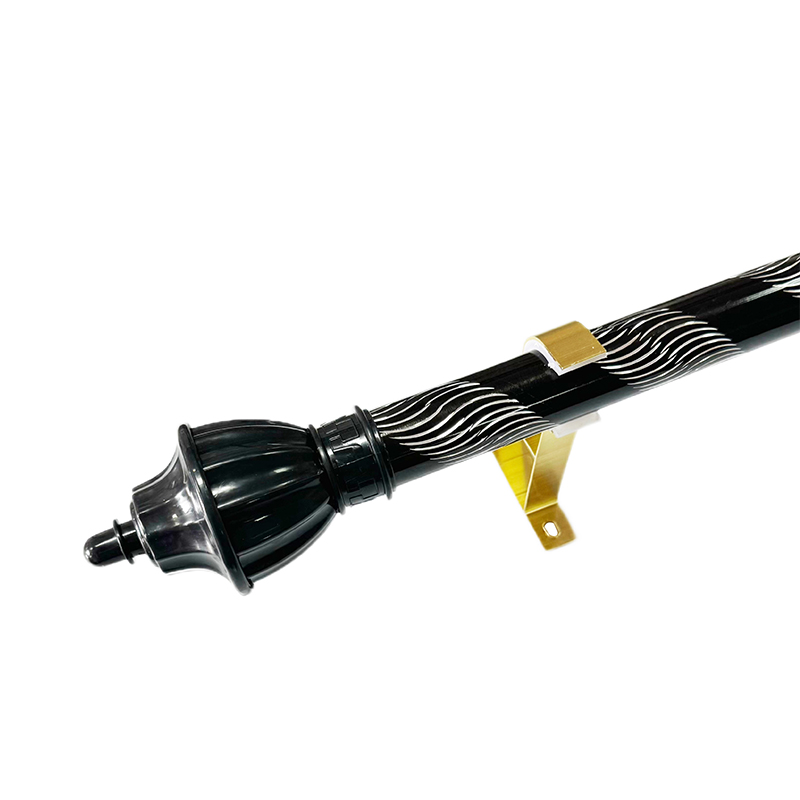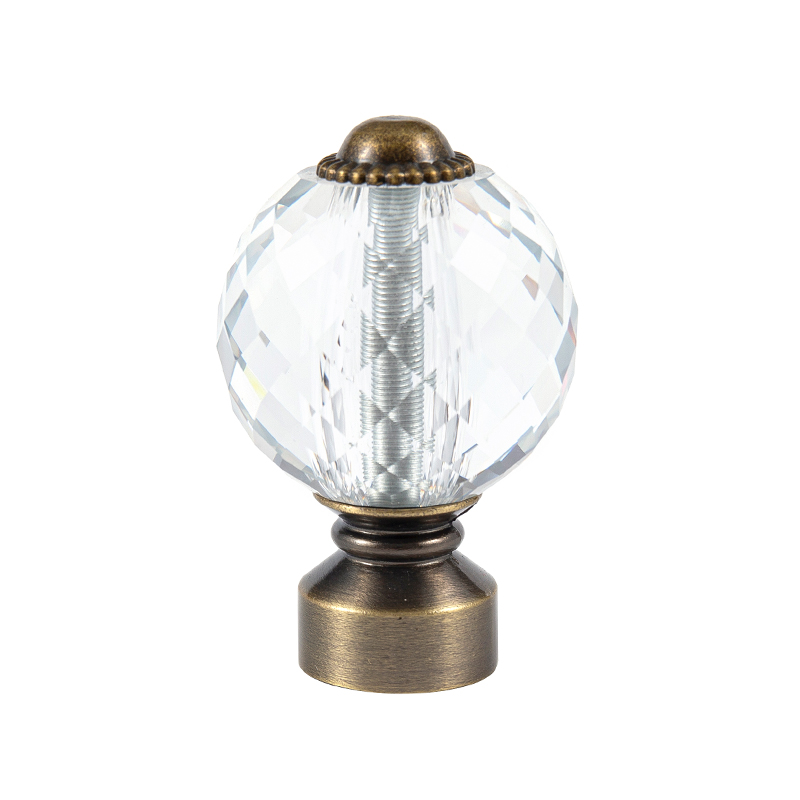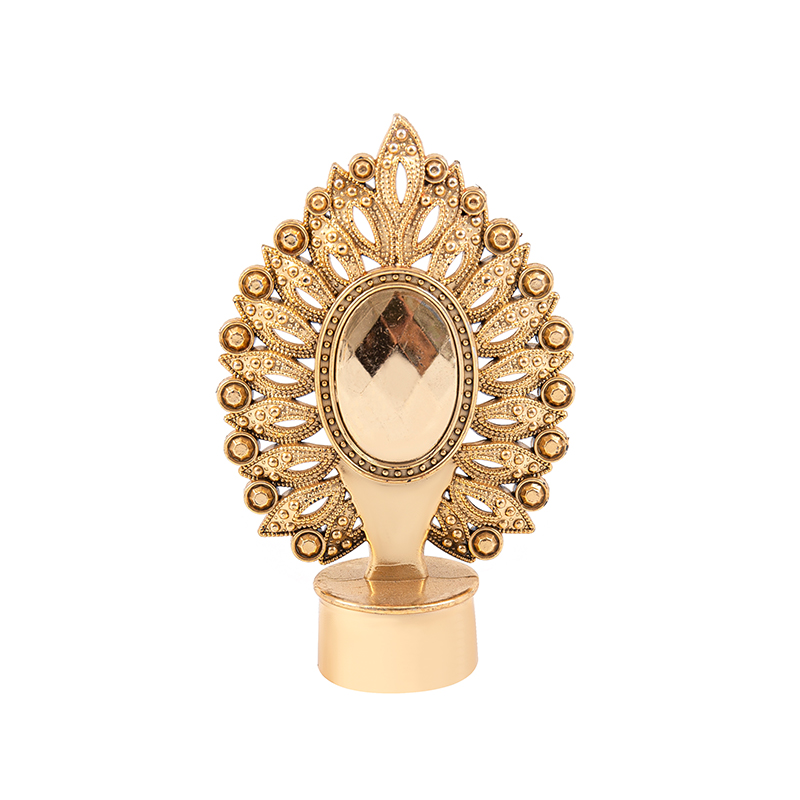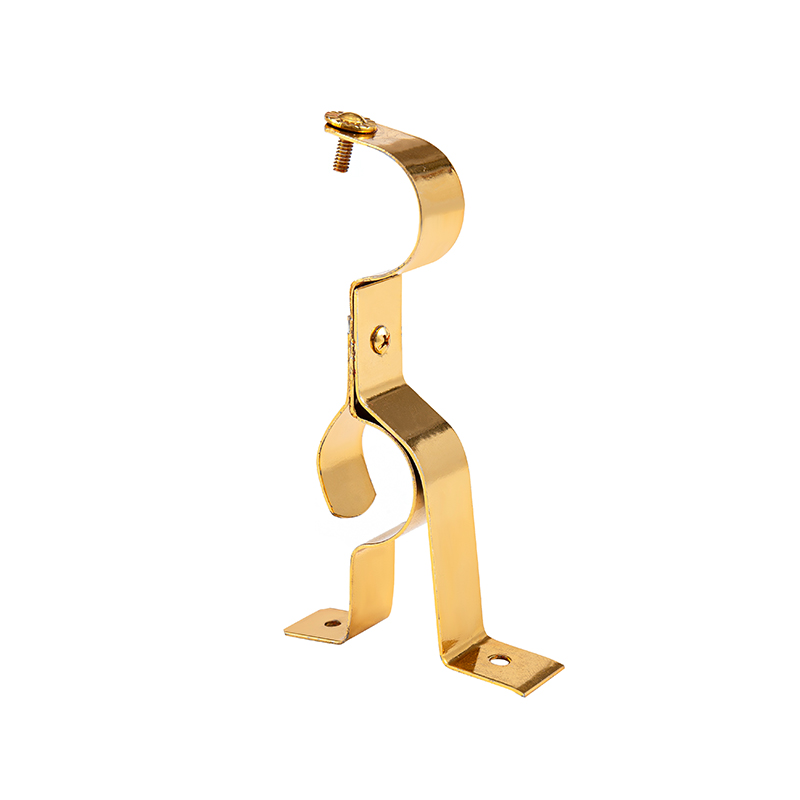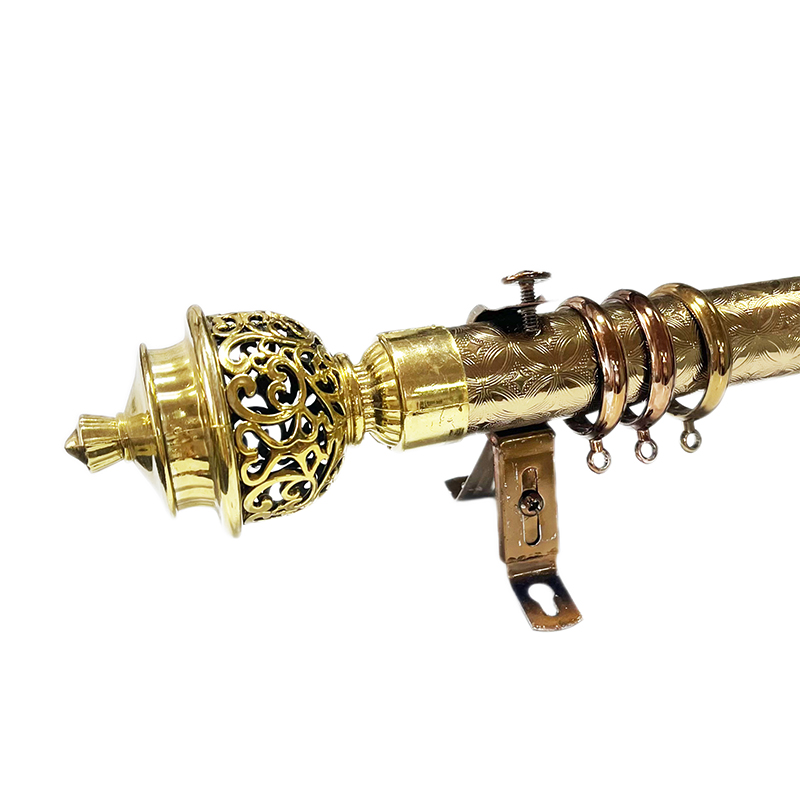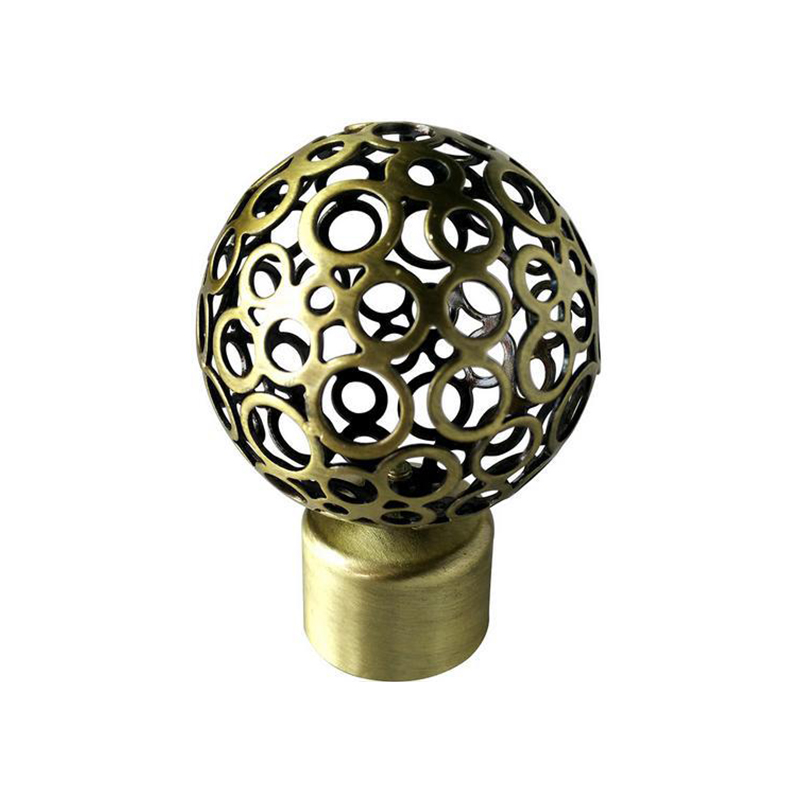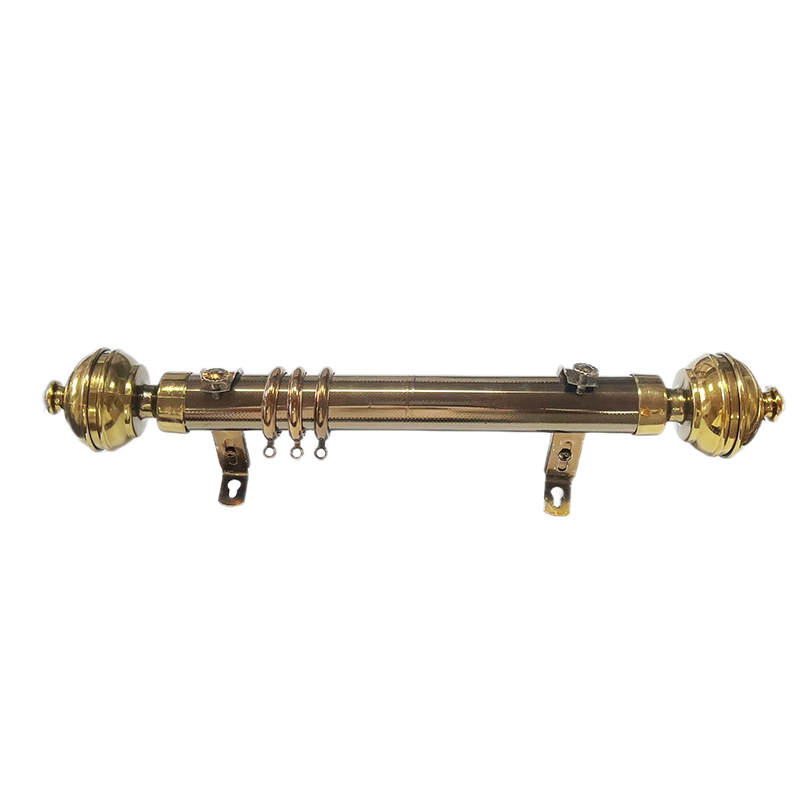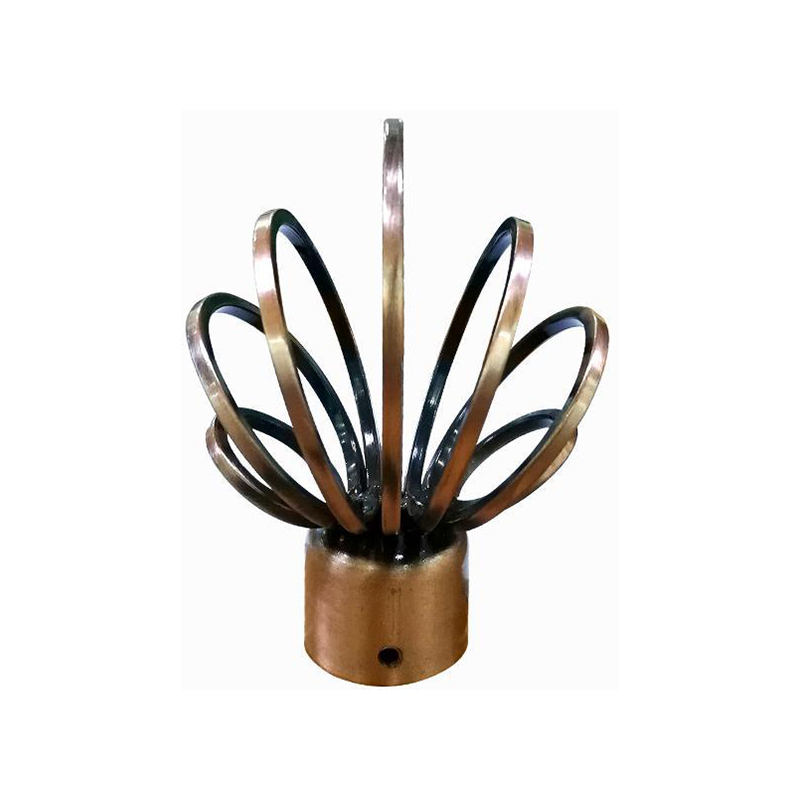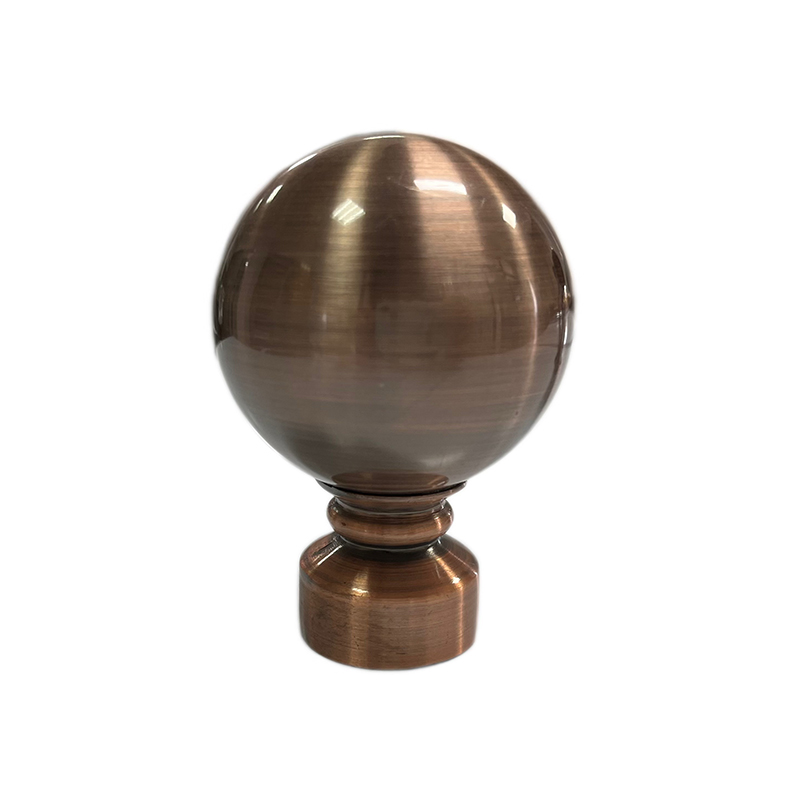Dual Role of Curtain Rod
As a household item, curtain rod has long been regarded as a simple and practical "support". People usually consider it together with curtains, believing that its main function is to support curtains, control light, and thus protect privacy. With the changes of the times, the role of curtain rod has undergone profound changes. Today, curtain rod is not just a simple functional item, it has gradually transformed into an indispensable part of home decoration. Modern curtain rods are both functional and decorative, and undertake more complex tasks.
The basic function and decorative significance of curtain rods have always been the two core elements in its design evolution. Initially, the design of curtain rods was completely based on "practicality", focusing on how to firmly support curtains, how to ensure the convenient pulling of curtains, and how to physically protect curtains from daily wear and tear. However, with the continuous evolution of home design, curtain rods gradually got rid of the role of a simple "support" and began to incorporate more aesthetic elements, becoming an important part of home decoration.
The origin of functionality and decorativeness
The original curtain rod design had almost no competitors in terms of functionality. Traditional curtain rods are mainly made of wood, iron or simple metal materials, which are structurally stable and can carry curtains of different types and weights to meet basic needs. The function of curtain rods is almost "support" and "fixation". Its form is mostly simple straight or curved lines, simple and plain design, and almost no decorative considerations.
With the changes of the times, especially the advancement of industrialization, the materials of curtain rods have gradually diversified, and the design concept has also begun to change. Curtain rods have begun to pay more and more attention to the matching of the overall home style and the coordination of the color and material of the curtains themselves. The diversification of interior decoration styles requires curtain rods to consider aesthetics and visual effects more than "practical". Especially from the late 19th century to the early 20th century, the design of curtain rods gradually added decorative elements such as carving, inlay, and fine painting, and curtain rods began to have more personalized expressions. Its design is no longer simply to provide support for curtains, but has become an important tool for decorating space and enhancing the atmosphere of the room.
The dual mission of modern curtain rod
After entering modern society, the design of curtain rod has become more and more complicated. It is not only a support frame for curtains, but also a part of home aesthetics. The design of modern curtain rod emphasizes individuality and style unity. The selection of materials, forms, colors, etc. is closely related to the overall design style of the home. Different styles of home spaces, such as modern minimalist style, Nordic style, industrial style, etc., have different design requirements for curtain rods. The appearance and function of curtain rods need to find a balance in these designs, which should meet both practical needs and aesthetic standards.
In terms of functionality, the design of modern curtain rods continues its basic duty of supporting curtains, but there are many innovations in details. For example, the length, diameter, and load-bearing capacity of curtain rods can be adjusted according to the weight and design requirements of curtains to ensure that curtains can be pulled smoothly and have a long service life. The surface treatment technology of curtain rods has also been continuously improved, using stainless steel, electroplating, spraying and other technologies, which not only enhances its durability, but also improves the visual effect.
In terms of decoration, the appearance design of curtain rods has far exceeded the scope of traditional functional items. As home decoration pays more and more attention to details and taste, curtain rods have gradually become part of home decoration. For example, metal curtain rods can complement modern minimalist homes, while wooden or copper curtain rods are more suitable for classical, rural or retro home environments. At the same time, the detailed design of curtain rods such as hooks, brackets, decorative rings, etc. has also begun to focus on refinement and personalization, and the choice of color, material, and shape can be perfectly integrated with almost any style of room.
Balance between function and decoration
The design evolution of curtain rods reminds us that functionality and decoration are not mutually exclusive, but can complement each other. The design requirements of modern curtain rods must take into account both aspects, that is, on the basis of ensuring its functionality, give it aesthetic value. How to achieve a balance between function and decoration in the design of curtain rods has become a challenge faced by many home designers. The curtain rod must not only be able to firmly support the curtains and ensure the normal use of the curtains, but also be able to enhance the overall beauty of the interior space, making it a highlight that cannot be ignored in the home environment.
Early functional design of curtain rod
As a household item, the initial design of curtain rod was completely functional, focusing on solving the basic problems of curtain hanging in real life. The earliest curtain rods were not as diverse and decorative as they are today. Their designs were simple and plain, and almost no aesthetic factors were considered. As human demand for home environment gradually increased, the function of curtain rod gradually changed from a simple support tool to a home element with certain decorative features. However, the early design was completely based on "support" and "stability" as the core goals, focusing on the stability and practicality of the structure.
The main functions of early curtain rods: supporting curtains, shading, and protecting privacy
The original design purpose of curtain rods was to solve the problem of curtain hanging. From the earliest use history of curtain rods, their basic functions are nothing more than supporting curtains, shading, and protecting privacy.
- Supporting curtains: In the era when there was no modern curtain rod, the use of curtains mostly relied on simple ropes or hooks for hanging. As the use of curtains became popular, people began to realize the need for a more sturdy and convenient device to hang curtains. Therefore, the earliest design of the curtain rod focused on providing a stable support system to ensure that the curtain can be safely hung on the window and effectively perform its function. Especially in the case of large windows or heavy curtains, the curtain rod needs to have sufficient strength to support the weight of the curtain and prevent the curtain from falling or deforming.
- Shading function: The curtain rod itself does not directly affect the shading function of the curtain, but its existence determines the way the curtain is hung and how to effectively block light. The early design of the curtain rod was mainly practical, especially the need to block external light through curtains to ensure the privacy of the room. Whether it is the alternation of day and night or privacy protection, the effective shading of the curtain is closely related to the stable support of the curtain rod. A stable curtain rod can ensure that the curtain completely covers the window, thereby minimizing the entry of external light.
- Privacy protection: Another function of the curtain rod is to protect the privacy of residents. In the era without modern building materials and technology, windows are usually an important connection point to the outside world. The design of curtains and curtain rods directly affects the effect of privacy protection. The installation position and stability of the curtain rod determine whether the curtain can effectively block the window when needed to prevent external peeping and interference. Therefore, the early curtain rod design must not only ensure that the curtain can be opened and closed conveniently, but also consider the effective coverage of the curtain in the design to ensure the privacy needs of the residents.
Material selection: simple materials such as wood and iron, focusing on load-bearing and practicality
In the early design of curtain rods, the selection of materials was mainly based on load-bearing and practicality, while aesthetics and decorativeness were hardly taken seriously. Wood and iron are the most common materials, which have stability and durability and can bear a large weight.
- Wood: Wooden curtain rod is one of the earliest common designs. Wood is a widely used material in ancient architecture. It has strong and high processability and can be made into a variety of shapes. Wooden curtain rods are usually made of rough and strong logs, which can carry heavier curtain fabrics. The natural texture of wood materials also adds some natural and warm atmosphere to the indoor environment. Although early wooden curtain rods focused on functionality, over time, the texture and feel of the wood itself also added a certain decorativeness to the curtain rod.
- Iron: Iron curtain rods were also very common in many historical periods. Iron is particularly outstanding in terms of load-bearing and durability, and is particularly suitable for the use of heavy curtains. Iron curtain rods can effectively avoid the deformation problem of wooden curtain rods due to humid environments. In addition, the metallic luster of iron curtain rods can be properly matched with some classical or industrial style homes. Early iron curtain rods not only focused on functionality, but also had a certain decorative feel through iron carving or polishing.
- Other materials: Early curtain rods also used some other materials, such as copper or bamboo curtain rods. Copper materials have been used in curtain rod designs in some areas because of their sturdiness and corrosion resistance. Bamboo curtain rods are common in tropical or subtropical areas. The naturalness and flexibility of bamboo make it a low-cost and environmentally friendly option.
Simplification of functional design: basic functions dominate, focus on structural stability
The design concept of early curtain rods emphasized the realization of basic functions, and its structural design mainly pursued stability and simplicity rather than complex appearance or decorative effects.
- Structural stability: In the design of early curtain rods, stability is the most important consideration. The design of the curtain rod must be able to bear the weight of the curtains and ensure that the curtains will not slip or bend during the pulling process. Therefore, the structure of the curtain rod is very simple and sturdy, usually linear, with a simple hanging method without involving complex structures or adjustment functions. The design goal of early curtain rods is to ensure that the curtains can be hung steadily and move smoothly.
- Function-dominated design: Since the main function of early curtain rods is to support curtains, their design gives priority to the realization of functions. Whether it is the hanging method, fixing method, or the size and strength of the curtain rod, it focuses on meeting basic usage needs rather than pursuing beauty or decorative effects. The simple design not only helps to improve the practicality of curtains, but also allows curtain rods to adapt to the use of a variety of homes or places.
- Simplified decoration: Under the design concept dominated by function, the decorativeness of curtain rods is almost non-existent, and even simple carvings and decorative details are very rare. Curtain rods are mostly straight-line, simple in shape and clear in structure. Although the decorativeness of curtain rods has gradually been valued in later historical stages, its decorativeness was almost negligible in the early days.
Industrial Revolution and Improvement of Curtain Rod Functionality
The Industrial Revolution was a major historical period from the mid-19th century to the early 20th century. It not only profoundly changed the global economic and social structure, but also had a profound impact on home design and the manufacturing process of furniture products. In terms of the design and function of curtain rods, the Industrial Revolution brought significant innovations, especially in terms of material use, manufacturing process and functional design, laying the foundation for the improvement of curtain rods.
The rise of metal materials and the transformation of curtain rod design
Before the Industrial Revolution, curtain rods were mainly made of traditional materials such as wood and iron. However, with the advancement of metal smelting technology, metal materials such as steel and aluminum alloys have gradually become the mainstream materials commonly used in curtain rod design. This transformation not only improves the functionality of curtain rods, but also makes the appearance and design of curtain rods more diverse.
- Popularization of metal materials: The Industrial Revolution promoted the rapid development of the metallurgical industry. Metal materials such as steel and aluminum alloys gradually replaced wood and traditional iron materials and were widely used in construction, furniture and home decoration. Curtain rods, as a home decoration, also began to use metal materials. Metal curtain rods have higher strength and durability than wooden and iron curtain rods, can withstand greater pressure and weight, and adapt to more diverse types of curtains. For example, heavier curtain fabrics or fabric curtains require a stronger support structure to ensure their normal operation, and metal curtain rods can meet this requirement.
- Corrosion and rust resistance: Metal curtain rods also perform better than wooden materials in corrosion resistance and durability. In particular, materials such as aluminum alloys and stainless steel perform well in humid environments and will not corrode, deform or fade due to moisture or air. Therefore, metal curtain rods are particularly suitable for humid environments such as kitchens and bathrooms. In addition, metal curtain rods can also resist ultraviolet rays and maintain a long-term stable appearance. They will not fade or crack due to sunlight like wooden curtain rods.
- Design diversity: With the use of metal materials, the appearance design of curtain rods has become more diverse. Metal curtain rods can present a variety of textures and effects through different surface treatment processes. For example, polished stainless steel curtain rods have a glossy feel and are suitable for modern minimalist homes; while iron curtain rods that have been sprayed can imitate bronze or black, with a retro feel, suitable for classical homes. These metal curtain rods not only have a higher load-bearing capacity, but also enhance the decorative effect, becoming an indispensable part of home design.
Improvement in durability and cost-effectiveness of metal curtain rods
The popularity of metal curtain rods after the industrial revolution not only makes curtain rods more durable, but also greatly reduces the production cost of curtain rods, making it the choice of more families.
- Improved durability: Compared with wooden curtain rods, metal curtain rods have stronger durability in long-term use. Metal materials are not only strong, but also have high impact resistance and deformation resistance, avoiding the expansion, contraction or breakage of wooden materials due to moisture or temperature changes. In particular, materials such as aluminum alloys and stainless steel can not only bear heavy curtains for a long time, but also will not corrode easily, and the surface is not easy to scratch. This makes metal curtain rods an ideal long-term investment that can maintain stable performance over a long period of time.
- Reduce production costs: With the promotion of industrialized production, the manufacturing cost of metal curtain rods has gradually decreased. In the past, the production cost of metal curtain rods was high due to the complex metal smelting and processing technology. But after the industrial revolution, the popularization of metal processing technology and the automation of production lines have made the production of metal curtain rods more efficient and cost-controllable. This enables metal curtain rods to not only meet higher requirements in terms of function, but also be more competitive in price, making it gradually become a popular product that more families can afford.
- Adapt to changes in market demand: The social changes brought about by the industrial revolution have also promoted changes in home decoration styles. With the progress of industrialization, urbanization and the rise of the middle class have enabled more families to have the ability to carry out home decoration. As an important part of home decoration, the market demand for curtain rods has grown rapidly. In this context, the popularity of metal curtain rods not only provides higher load-bearing capacity and service life, but also caters to the needs of different consumers for the appearance design and function of curtain rods.
The emergence of decorative design
With the continuous advancement of industrialization from the late 19th century to the early 20th century, home design and furniture manufacturing have undergone tremendous changes. Curtain rod, as a vital part of the home environment, its design is not limited to functional requirements, but also began to add more and more decorative elements. Curtain rod, which was originally used only to support curtains and block light, has gradually become an aesthetic element that echoes the overall home decoration style. As consumers' aesthetic requirements increase, the design of curtain rods begins to incorporate more exquisite crafts such as carving, inlay, and painting, gradually breaking away from the scope of purely functional items and becoming part of home space decoration.
The rise of curtain rod decorative design in the late 19th century and early 20th century
From the late 19th century to the early 20th century, with the prosperity of social economy and the continuous development of art and culture, home decoration styles have gradually become diversified and refined. The Industrial Revolution not only promoted the improvement of productivity, but also popularized a large number of craft technologies. At this time, furniture design no longer only focuses on practicality, but also begins to emphasize aesthetics and decorativeness. The design of curtain rods has changed accordingly, and began to pay attention to details, striving to further enhance its decorative and visual effects in addition to structural stability and functionality.
- Diversification of home styles: From the late 19th century to the early 20th century, Western home decoration styles showed a trend of diversification. From classicism to Baroque style, to neoclassicism and Victorian style, different home styles have different requirements for the design of curtain rods. In this context, the design of curtain rods no longer just meets functional needs, but becomes an extension of decorative style. The design of curtain rods began to incorporate elements and artistic styles of different cultures, becoming an important part of home space design.
- The rise of the middle class: With the rise of the middle class, more and more families have begun to pay attention to the details of home decoration. As an important part of household items, curtain rods have received more and more attention. Middle-class consumers not only pursue the improvement of their quality of life, but also hope to show their personal taste through home decoration. The decorative design of curtain rods has begun to become an important consideration in home decoration.
Addition of decorative details: carving, inlay, painting and other processes
With the continuous development of home decoration style, the functional design of curtain rods has gradually been influenced by aesthetic pursuits, and decorative details have begun to increase. Curtain rods are no longer a simple supporting tool, and their design begins to focus on detail processing to meet the dual needs of beauty and function. Decorative processes such as carving, inlay, and painting have become an important part of curtain rod design, and the appearance of curtain rods has become more refined and diverse.
- Carving process: Carving is one of the most common decorative processes in curtain rod design from the late 19th century to the early 20th century. Carving not only enhances the decorativeness of curtain rods, but also gives them a higher artistic value. Especially in classical or Victorian-style homes, the use of carving technology is particularly extensive. The exquisite patterns, reliefs, lines and other carvings on curtain rods can often echo other decorative elements in the room such as furniture, curtains, wallpaper, etc., and enhance the beauty of the entire space. For example, wooden curtain rods with gold inlays or carvings often become highlights in traditional homes, with a strong sense of history and aristocratic temperament.
- Inlay: As a decorative technique, inlay was first used in luxurious palaces and aristocratic residences. With the advancement of the Industrial Revolution, inlay has gradually entered the home design of ordinary families. The inlay process on the curtain rod usually uses metal, glass, ceramics and other materials, which are finely polished and installed to present a gorgeous and unique visual effect. For example, jewelry, glass balls, copper ornaments and other materials can be embedded at both ends or joints of the curtain rod. This design can not only enhance the decorativeness of the curtain rod, but also form a harmonious visual transition between the curtain rod and the surrounding environment.
- Painting and decorative coating: Paint is another way to make the curtain rod more decorative. The appearance of the curtain rod becomes richer through painting with different colors and textures. Especially for curtain rods made of metal, the painting process can add gloss and modernity to it, and at the same time, it can provide more decorative effects while maintaining its durability. For example, black, white, gold and copper paint effects are widely used on curtain rods. Different tones can match the overall decoration style of the interior and enhance the layering and visual effect of the space.
Curtain rod becomes part of home decoration
The decorative design of curtain rod is not only reflected in its appearance, but also gradually integrates with the overall style of the home, becoming an indispensable part of home decoration. From the initial practical tool to the gradual evolution of visually attractive home elements, the decorative design of curtain rod shows the dual pursuit of aesthetics and function in home culture.
- The unity of home style: With the rise of curtain rod decorative design, the shape, material and decorative details of curtain rod have become more and more focused on the unity with the overall style of the room. Whether it is the elegant Victorian style or the simple and modern Nordic style, the design of curtain rod begins to form an organic whole with other elements such as furniture, curtains, carpets, etc. in the space. The choice of curtain rod not only depends on its functional needs, but also needs to be matched according to the decoration style of the space to form visual harmony.
- The artistic value of curtain rod: In the early 20th century, curtain rod gradually ceased to be a simple home accessory, but became a work of art. Many exquisite curtain rod designs are not only practical, but also have extremely high artistic value. The fine carving, inlay and painting techniques make the curtain rod itself a highlight in the home space. With the improvement of the decorativeness of the curtain rod, the curtain rod is no longer just a tool for decorating the space, it has become the core part of the decoration, reflecting the taste and aesthetic pursuit of the residents.
- The influence of decorative design: The decorative design of the curtain rod not only affects the decoration style of the family, but also promotes the development of the entire home design industry. Many designers have begun to pay attention to the design of the curtain rod, regard it as part of the home design, and explore the integration of different materials, shapes, colors and craftsmanship. The rise of this decorative design not only continues the functionality of the curtain rod, but also makes it an element that cannot be ignored in home design.
Mid-20th century: the rise of modernization and minimalist style
In the mid-20th century, the rise of modernist design thought completely changed the global architecture and home design. The simple and functional modern style gradually replaced the traditional design concept of overly complicated decoration, advocating the design philosophy of "less is more". This change is not only reflected in architecture and furniture, but also has a profound impact on the design of curtain rods. From the complicated decoration of the past to the modern and minimalist design, curtain rods, as an important accessory in the home, have gradually been integrated into modern style homes, emphasizing practicality, simplicity and the overall unity of space.
The rise of modernist design and the simplification of curtain rod design
In the mid-20th century, modernist design gradually became the mainstream. The core concept of this design trend is "form follows function", that is, emphasizing functionality and practicality, and abandoning excessive decoration and cumbersome details. Driven by this design trend, the design of curtain rods has also undergone fundamental changes. The complicated carving, inlay and decoration techniques in the past have been gradually simplified, and the appearance of the curtain rod tends to be simple and linear, paying more attention to its coordination and practicality in the home space.
- Simple lines and shapes: Modernist design emphasizes simple geometric shapes, and the design of curtain rods has also begun to adopt simple and bright straight lines or circular stripes, removing complicated decorations and fancy details. Curtain rods no longer pursue luxury and complex patterns, but show elegance and refinement through simple shapes and smooth lines. This design style is highly consistent with the overall atmosphere of modern homes. It is not too eye-catching, but can naturally integrate into the overall space to form a harmonious and unified visual effect.
- Both functionality and decoration: Although modern design pursues simplicity, this does not mean giving up the decorativeness of curtain rods, but pursuing a balance between functionality and decoration. The design of curtain rods is no longer purely for decorative purposes, but also takes into account its function of supporting curtains and its harmonious matching with the indoor environment.
Material changes: lightweight and durable metal alloys and plastic materials
With the advancement of modern industrial technology, the types of materials and manufacturing processes have been greatly improved. The design materials of curtain rods are no longer limited to traditional wood, iron, etc., but have begun to use lightweight and durable materials such as metal alloys and plastics. These materials not only meet the requirements of modern homes for practicality and durability, but can also adapt to more diverse home styles.
- Application of metal alloy materials: In the mid-20th century, the emergence of metal alloys completely changed the structure and appearance of curtain rods. Compared with traditional iron curtain rods, metal alloys are lighter, stronger, and have stronger corrosion resistance and oxidation resistance. Metal materials such as aluminum alloys and steel are not only superior to wood in strength, but also can adapt to the weight requirements of different curtains. More importantly, the surface of metal alloys can be treated in various ways, such as anodizing, electroplating and spraying, so that they present a variety of appearance effects. The surface of these metal alloy curtain rods can have a smooth metal texture, or imitate the wood effect to meet the needs of different decorative styles.
- Popularity of plastic materials: In addition to metal alloys, plastic has also become one of the common materials in curtain rod design in the mid-20th century. Plastic curtain rods are usually made of materials such as PVC and polycarbonate (PC). These materials are not only lightweight, but also easy to process into various shapes, with low cost, and can meet the needs of the mass market. The biggest advantage of plastic curtain rods is their lightness and corrosion resistance, which makes them suitable for use in environments with heavy humidity such as kitchens and bathrooms. In addition, plastic curtain rods can be designed in a variety of colors and textures to adapt to different styles of homes.
- The emergence of new synthetic materials: With the development of materials science, in addition to traditional metals and plastics, curtain rods have begun to use some new synthetic materials, such as carbon fiber and composite materials. These new materials are not only ultra-light, but also have extremely strong strength and tensile resistance, which are particularly suitable for heavy curtains that require high-strength support. Due to their excellent corrosion and aging resistance, these materials have become an ideal choice for high-end curtain rods in modern homes.
Modern style curtain rod: overall home unity and simplicity
With the popularity of modern style, home design tends to be simple, practical and comfortable. Under this trend, the design of curtain rod pays more and more attention to the coordination with the overall home. Curtain rod is not just a tool to support curtains, it begins to become a part of home design, requiring a unified visual effect with other home elements such as furniture, floor, wall, etc.
- Minimalism and home unity: Modern style advocates minimalism, and this concept is particularly evident in the design of curtain rod. The design of curtain rod has become more low-key, often using inconspicuous colors and shapes to avoid excessive decoration. At the same time, the material and color of curtain rod will also be consistent with the material and color of other furniture in the room to achieve a sense of unity in the overall space. For example, curtain rods in neutral tones such as white, black, and silver can perfectly blend with the modern minimalist style home environment, will not be overwhelming, but can play a decorative role just right.
- The sense of lines and modernity of curtain rod: In modern home design, the shape of curtain rod pays more attention to the sense of lines. Simple straight, round or curved lines show the style of modern design and enhance the decorativeness of curtain rods. Modern curtain rods usually adopt straight lines or simple geometric shapes to avoid too much complicated decoration. The design of curtain rods makes the entire home space look more open and transparent, reflecting the pursuit of simplicity and comfort in modern life.
- Balance between function and aesthetics: In modern style homes, curtain rods are not only an indispensable decorative element in the home space, but also must meet functional requirements. Modern design emphasizes the balance between function and aesthetics. Curtain rods need to be able to bear the weight of curtains and visually fit in with the overall home environment. The combination of simple design concepts and efficient functions makes curtain rods a practical and beautiful home accessory in modern homes.
Modern design concept: the integration of function and aesthetics
In today's home design, the role of curtain rod is no longer limited to a simple supporting tool. With the continuous development of design concepts, curtain rod has gradually become an important decorative element in home space, and its functionality has been continuously improved. Modern curtain rods not only have to support curtains, shading, privacy protection and other basic functions, but also perfectly integrate with the overall home decoration style and become a part of interior design. At the same time, the addition of intelligent and adjustable functions has given curtain rods more practicality and convenience, making them both beautiful and with higher functional value. The diverse selection of colors, shapes and materials further reflects the modern home's demand for details and personalization.
Curtain rod as an element of home decoration: the perfect combination of function and aesthetics
Modern home design emphasizes the overall sense of space and the coexistence of decorativeness and practicality of each home item. Under the influence of this concept, curtain rods, as an indispensable part of home space, are increasingly designed to fit in with the overall room style, rather than simply emphasizing their supporting function. The appearance design, color tone, material, etc. of the curtain rod need to be closely matched with the overall style of the home to meet the dual needs of aesthetics and function.
- Harmony with the home style: Modern home design emphasizes "integrity" and "coordination", so the choice of curtain rod needs to take into account the decoration style of the space. For example, in a minimalist home, the curtain rod is usually based on simple and clean lines, and the material is mainly metal, glass, plastic and other modern materials. The color is generally neutral colors such as black, white or gray, reflecting the simplicity and modernity of the space. In a traditional style home, the design of the curtain rod can choose wood or metal with classical carvings, and the color tone tends to be dark, such as dark brown, gold, etc., which is in line with traditional aesthetics and consistent with the overall home decoration.
- Curtain rod as an aesthetic element: The curtain rod in a modern home is not only a practical accessory, but also an important part of home aesthetics. Designers have given the curtain rod a unique shape and decorative effect through detailed carving, so that it can add a sense of elegance and refinement to the interior without showing off. For example, the slender metal curtain rod, which is common in the minimalist style, has a strong sense of lines and can enhance the sense of space without being cumbersome. On the other hand, the exquisite design of the curtain rod can also become a highlight in the space, and its unique shape or material can add a lot of color to the whole room.
Color, shape and material of curtain rod: closely matched with home style
The design of modern curtain rod pays more and more attention to the harmonious coordination with home style. The choice of different colors, shapes and materials makes curtain rod not only a tool to support curtains, but also an important part of home decoration.
- Choice of color: The color of curtain rod needs to be coordinated with the color of the whole room. For example, in a modern home with a minimalist style, the color of curtain rod generally chooses low-key neutral colors such as black, white, and gray, which can blend with the overall color of the home and will not be too prominent. In a traditional style home, the color of curtain rod can choose gold, copper or wood grain color, etc., with a classical atmosphere, which can add elegance and warmth to the space.
- Choice of shape: The shape of curtain rod is a very important element in modern home design. Modern design advocates minimalism. The shapes of curtain rods are mostly straight lines, circles or simple geometric shapes. These designs can effectively enhance the modern and simple sense of space. For example, minimalist curtain rods usually adopt straight line design, single color, simple shape, and can form a harmonious match with other furniture. Some curtain rods with a strong sense of design may adopt some irregular shapes or curve designs to create a unique visual effect.
- Material selection: The material selection of curtain rod affects its appearance, durability and user experience. In modern homes, common materials for curtain rods include metal, wood, plastic, etc. Metal curtain rods, such as aluminum alloy and stainless steel, have strong load-bearing capacity, corrosion resistance and oxidation resistance, and are suitable for modern minimalist style homes. Wooden curtain rods are often used in classic or natural style homes. Its warm texture can bring a sense of comfort and intimacy to the space. Plastic materials are light and durable, and are usually used in places with low budgets or frequent replacements, such as children's rooms or rental houses.
Decorative design trends: Personalization and customization of curtain rod
With people's continuous pursuit of quality of life, the demand for personalization and customization of home decoration is increasing. Home decoration design is no longer a simple "follow the trend", but more reflects the life attitude, aesthetic taste and unique personality of each family owner. Curtain rod, as a vital part of home decoration, has gradually changed from the original single practical tool to a home element with strong decorativeness. Modern families not only pay attention to the functionality of curtain rods, but also pay more attention to their aesthetic value, personal expression and fit with the overall style in the home space. Therefore, the design of curtain rods also shows a trend of personalization and customization, which meets the pursuit of unique home styles by different consumers.
Increasing demand for personalization and customization in modern families
In modern home environments, consumers' demand for home products is no longer limited to practicality and durability. Personalization and customization have become one of the design trends, especially among young people, home design has become an important channel to show personal taste and lifestyle. From furniture, lighting to curtains and curtain rods, consumers are increasingly inclined to choose unique designs that can reflect their own style. For curtain rods, the demand for personalized design is particularly prominent. Consumers hope that through the customization of the color, shape, material and other aspects of the curtain rod, it can be beautiful and match the overall home style to show personality.
- Reflection of personalized home style: As "personalization" becomes the keyword of contemporary home design, more and more people want to integrate their personal preferences into home decoration, and curtain rods, as one of the details of home decoration, have become an important element to show personal style. Different curtain rods can not only change the way curtains are hung, but also affect the visual effect of the entire room.
- Fit with lifestyle: Modern home is no longer just a living space, it is also a carrier that reflects lifestyle and personality attitude. As one of the details of home design, curtain rods are also increasingly showing their personalized characteristics. Whether it is to better integrate into the overall design style or to show the owner's taste, the demand for customization of personalized curtain rods is increasing. Whether it is material selection, color or form, consumers can customize according to their preferences and the characteristics of the space.
Diverse design: customized curtain rods are provided according to the home decoration style
The customized design of curtain rods has become a trend, and more and more brands and designers focusing on providing customized curtain rods have emerged in the home market. Consumers can choose the appropriate curtain rod design according to the characteristics of their home decoration style. The diversified design of curtain rods is not only reflected in the choice of materials and shapes, but also in color, surface treatment technology and other aspects. Customized curtain rods can be better integrated into the home decoration style, not only adding beauty to the home space, but also reflecting the unique taste of the home owner.
- Customized design according to style: There are many styles of home furnishing, including modern minimalist style, Nordic style, retro style, country style, etc., and each style has different requirements for curtain rods. Modern minimalist style curtain rods usually have simple lines and smooth shapes. Common materials are metal or plastic, and the colors are mostly black, white or gray. Nordic style homes pay more attention to natural and simple elements. The materials of curtain rods are often wood or metal materials with natural textures, and the colors are mainly light colors. Retro-style curtain rods may choose retro tones such as gold and copper, and combine details such as carvings and decorations to enhance the gorgeousness of the space. Customized design can provide matching curtain rods according to the style of the home, ensuring the overall harmony of the home style.
- Adapt to the needs of different spaces: The function and sense of space of each room are different, and the choice of curtain rods should also be adapted to local conditions. The demand for curtain rods in bedrooms, living rooms, kitchens and even bathrooms varies greatly. For example, bedrooms and living rooms usually require more decorative and stable curtain rods, while kitchens and bathrooms require more durable and easy-to-clean curtain rods. Customized curtain rods can be designed according to the functional requirements of different spaces to ensure that the curtain rods are not only beautiful but also meet the needs of practical use.
- Introduction of multifunctional design: Customized curtain rods can also provide more functional designs according to the special needs of customers. For example, curtain rods with intelligent functions such as lifting and rotating can be customized to meet the needs of modern families for convenience and comfort. The accessories of curtain rod can also be customized, such as matching different styles of curtain rings, fabric clips, decorative heads, etc., to make the overall design more perfect.
Decorative functions of curtain rod: from simple black and gold to retro and modern art style selection
The design of modern curtain rod is becoming more and more artistic. Curtain rod is not only a practical accessory, but also a part of the home space, participating in the overall layout of space decoration. Modern families have more diverse requirements for the decorativeness of curtain rods. While meeting the functionality of curtain rods, designers pay more attention to its visual performance, and strive to make it a highlight of home decoration through unique design.
- Simple and atmospheric color selection: Traditional curtain rod colors are mainly black, white, gold, etc. These colors are classic and durable, suitable for various home styles. But with the diversification of home design, the color selection of curtain rods has become richer. For example, modern minimalist style families may prefer simple black or gold curtain rods, while retro style families may prefer dark brown, bronze and other more historical colors. In order to better match the home style, consumers can now choose to customize the color of the curtain rod, whether it is bright gold, elegant silver, or high-end black or rustic bronze, they can find a suitable place in the home design.
- Combination of retro and modern art styles: As people's requirements for home aesthetics increase, more and more curtain rod designers are beginning to explore the design method of combining retro and modern art styles. Retro curtain rods usually use fine carvings or decorative designs, and the color tone tends to be gold, copper or dark wood, which can bring a sense of history and heaviness to the space. Modern art style curtain rods often use bold shapes and innovative materials, such as using metal curtain rods with irregular geometric shapes, or combining multiple materials such as glass, wood and metal to form a unique artistic effect.
- Personalized pattern and material design: Against the background of increasing personalized needs, the patterns and materials of curtain rods are gradually becoming more diverse. Consumers can customize the patterns of curtain rods according to their preferences, such as choosing floral patterns, geometric patterns, or even brand logos or specific symbols as decorations to enhance the personalized effect. At the same time, the diversity of materials is also an important manifestation of personalized design. The combination of glass, ceramics, wood, metal and other materials provides more design possibilities for curtain rods and meets the different needs of different consumers.

 English
English Français
Français عربى
عربى
